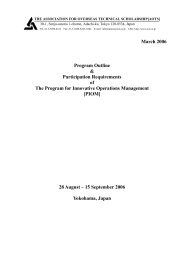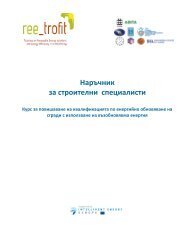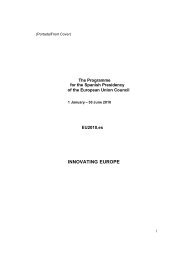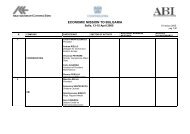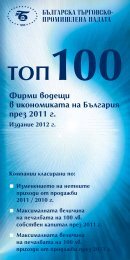Analysis of the Operation and Financial Condition of the Enterprise
Analysis of the Operation and Financial Condition of the Enterprise
Analysis of the Operation and Financial Condition of the Enterprise
You also want an ePaper? Increase the reach of your titles
YUMPU automatically turns print PDFs into web optimized ePapers that Google loves.
<strong>Analysis</strong> <strong>of</strong> <strong>the</strong> <strong>Operation</strong> <strong>and</strong> <strong>Financial</strong> <strong>Condition</strong> <strong>of</strong> <strong>the</strong> <strong>Enterprise</strong> Pr<strong>of</strong>itability <strong>of</strong> investing (return on investment) – how efficiently <strong>the</strong> assets havebeen used in pr<strong>of</strong>it-making. <strong>Financial</strong> pr<strong>of</strong>itability (return on capital employed) - how much pr<strong>of</strong>it has beenmade by <strong>the</strong> enterprise owners per one unit <strong>of</strong> capital invested.The group <strong>of</strong> trading pr<strong>of</strong>itability measures includes <strong>the</strong> following ratios: Pr<strong>of</strong>itability <strong>of</strong> sales; Pr<strong>of</strong>itability <strong>of</strong> operating activities; Gross pr<strong>of</strong>it margin.Within <strong>the</strong> group <strong>of</strong> <strong>the</strong> trading pr<strong>of</strong>itability measures <strong>the</strong> return on sales ratio isused most commonly. Pr<strong>of</strong>itability from sales is <strong>the</strong> relation between <strong>the</strong> financial amountfigure <strong>and</strong> <strong>the</strong> volume figure, or - how much pr<strong>of</strong>it is gained per each unit <strong>of</strong> net turnover.Besides, this ratio reflects <strong>the</strong> pr<strong>of</strong>it made as a result <strong>of</strong> both sales <strong>of</strong> goods <strong>and</strong> services<strong>and</strong> <strong>the</strong> costs <strong>and</strong> revenues which are not directly attributable to production <strong>of</strong> goods orprovision <strong>of</strong> services (miscellaneous extraordinary revenues, taxation payable, transactionswith securities <strong>and</strong> o<strong>the</strong>rs). It is calculated as follows:Pr<strong>of</strong>it or loss in <strong>the</strong> reporting periodTrading pr<strong>of</strong>itability 100 % (4.25.)Net turnoverNet pr<strong>of</strong>it is <strong>the</strong> share <strong>of</strong> <strong>the</strong> enterprise pr<strong>of</strong>it remaining at <strong>the</strong> disposal <strong>of</strong> anenterprise after tax, while net turnover is revenue from sales <strong>of</strong> goods <strong>and</strong> services aftertax, which is estimated based on <strong>the</strong> sales turnover <strong>and</strong> value <strong>of</strong> goods returned.Ratio between pr<strong>of</strong>it <strong>and</strong> <strong>the</strong> amount <strong>of</strong> turnover generally describes whe<strong>the</strong>r <strong>the</strong>competitiveness <strong>of</strong> an enterprise has changed compared to <strong>the</strong> previous year. If this valuehas increased compared to <strong>the</strong> preceding period, this would indicate that an enterprise hasimproved its competitiveness.Pr<strong>of</strong>itability <strong>of</strong> sales can be increased by reducing <strong>the</strong> costs, increasing <strong>the</strong> priceper unit <strong>of</strong> goods or by speeding up <strong>the</strong> rate <strong>of</strong> increase in <strong>the</strong> amount <strong>of</strong> goods soldcompared to <strong>the</strong> rate <strong>of</strong> cost increases. For example, costs may be reduced by usingcheaper raw materials <strong>and</strong> components, by automating <strong>the</strong> production <strong>and</strong> increasinglabour productivity etc.It is also necessary to calculate <strong>the</strong> pr<strong>of</strong>itability which is unaffected by <strong>the</strong> taxrates, any interest paid <strong>and</strong> received etc., but that are only affected by <strong>the</strong> operating resultsin an enterprise, its pricing policy etc. Therefore, <strong>the</strong> pr<strong>of</strong>itability <strong>of</strong> operating activities isused in <strong>the</strong> financial analysis. This measure is used to identify <strong>the</strong> efficiency <strong>of</strong> operations<strong>and</strong> sales in earning <strong>the</strong> income <strong>and</strong> it describes <strong>the</strong> operating efficiency <strong>of</strong> an enterprise.Earnings beforeinterest <strong>and</strong> taxesPr<strong>of</strong>itability <strong>of</strong> operating activities 100 % (4.26.)Net turnover<strong>Enterprise</strong> managers are always interested in <strong>the</strong> achievement <strong>of</strong> a higherpr<strong>of</strong>itability <strong>of</strong> operating activities as this measure reflects <strong>the</strong> efficiency <strong>of</strong> <strong>the</strong> goodsproduction <strong>and</strong> sales operations in making <strong>the</strong> pr<strong>of</strong>it.One <strong>of</strong> <strong>the</strong> measures in analysis <strong>of</strong> <strong>the</strong> business financial activities is <strong>the</strong> grosspr<strong>of</strong>it margin. According to <strong>the</strong> dynamics <strong>of</strong> gross pr<strong>of</strong>it conclusions can be made about<strong>the</strong> reasons for <strong>the</strong> changes. The changes may be due to <strong>the</strong> following: increase in netturnover as well as <strong>the</strong> increase or decrease in operating costs.82



